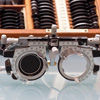The optic nerve is a bundle of over one million nerve fibers responsible for transmitting visual information from the retina to the brain. While there are many ophthalmic conditions that affect optic nerve function, Optic Neuritis and Ischemic Optic Neuropathy are two of the more commonly seen disorders within an ophthalmology practice.
Optic Neuritis
What is Optic Neuritis?
Optic neuritis is inflammation of the optic nerve that often presents with pain upon eye movement, blurred vision or blind spots in the visual field and loss of color vision. While it usually occurs in one eye, it can occur simultaneously in both eyes. Optic neuritis occurs in more women than men and usually before the age of 45. It often develops as a result of an autoimmune disorder such as multiple sclerosis (MS); a condition in which the immune system attacks the protective covering (myelin sheath) that insulates the nerve fibers in the brain and spinal cord. It may also develop as a result of bacterial infection, diabetes, and blood vessel inflammation.
What are the treatments for Optic Neuritis?
Most people who experience a single episode of optic neuritis recover their vision without treatment, but in some cases, IV steroids followed by a course of oral steroids are prescribed to help reduce the inflammation. For those with MS, episodes of optic neuritis may recur, potentially leading to optic neuropathy and long-term vision loss. If recurrent optic neuritis occurs in those without an autoimmune disorder, the prognosis is usually very good that their vision will be restored.
Ischemic Optic Neuropathy
What is Ischemic Optic Neuropathy?
Ischemic optic neuropathy can be likened to a stroke of the optic nerve, as it is the result of a blockage of its blood supply. Permanent loss of vision is the main symptom and may occur within minutes to several days. Depending on the cause, vision may be affected in one or both eyes.
Two types of ischemic optic neuropathies may occur including arteritic and nonarteritic. Arteritic ischemic optic neuropathy (AION) most often occurs in people over the age of 70. Often it is caused by temporal arteritis (giant cell arteritis), or inflammation of the arteries. The inflamed arteries block the blood supply to the optic nerve, causing damage as a result. Treatment of arteritic ischemic optic neuropathy includes high doses of steroids to prevent loss of vision in the other eye.
Nonarteritic ischemic optic neuropathy occurs most often in people over the age of 50 with risk factors such as high blood pressure, diabetes and atherosclerosis (hardening of the arteries). Treatment involves controlling blood pressure, diabetes, cholesterol and other factors that affect the blood supply to the optic nerve. About 40% of nonarteritic ischemic optic neuropathy patients improve spontaneously over time.
Anatomy: Optic Nerve


Fifth Avenue Associates
1034 Fifth Avenue
New York, NY 10028
Phone: 212-570-0707
Fax: 212-570-0555
Email: [email protected]

Dry Eye Syndrome
Cataracts
Droopy Eyes
Bags Under The Eyes
Ptosis
Ectropion/Entropion
Eyelid Cancers
Refractive Surgery
Thyroid Eye Disease
Tear Duct Conditions
Pediatric Eye Care
Blepharospasm

For contact details and patient forms please click below.

Your gift can help Virtue Foundation tackle critical issues and make a positive impact around the globe.

Click here to view and listen to the latest Fifth Avenue Associates audio/Video Clips